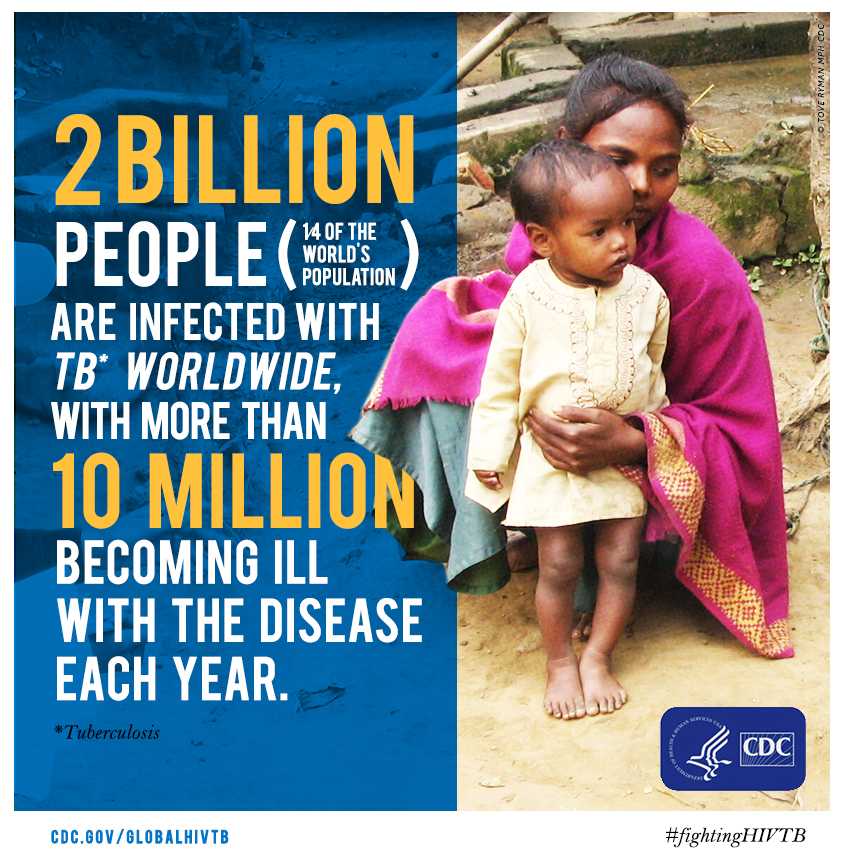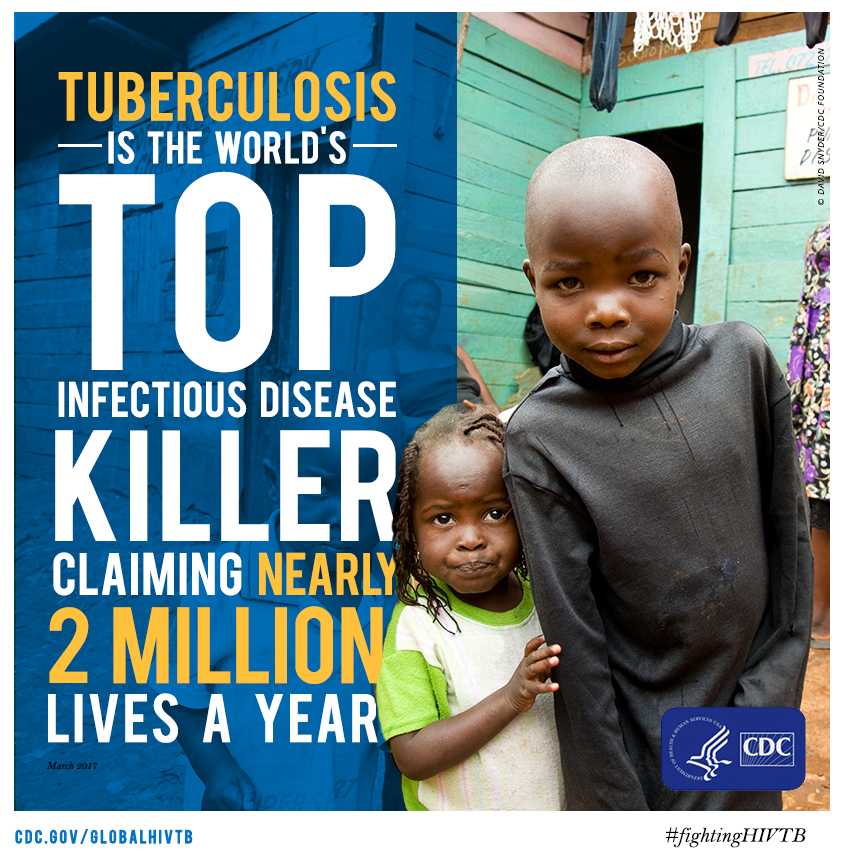World TB Day 2017
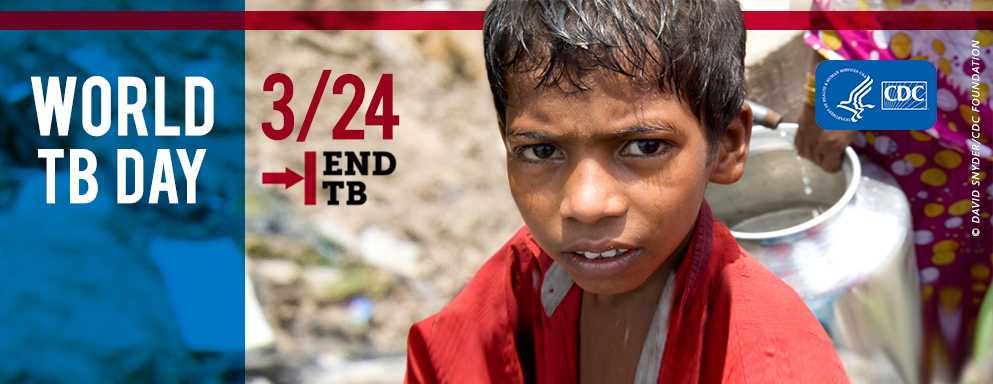
Every March 24, CDC recognizes World Tuberculosis (TB) Day – a day when organizations from around the world Unite to End TB by calling attention to the continued threat of this ancient and deadly disease and what’s needed to eradicate it. Despite decades of efforts and significant progress in the fight against TB, it still kills more people than any other infectious disease. Today, 2 billion people – one fourth of the world’s population – are infected with TB worldwide, with more than 10 million becoming ill from the disease and at risk for transmitting TB to others.
TB is a serious challenge to America’s health, safety, and security. It spreads through the air from person to person and respects no borders. That’s why CDC is partnering with 25 countries to find, cure, and prevent TB across the globe. As a result, CDC is helping to create a safer America and a safer world.
In support of World TB Day, CDC’s Division of Global HIV & TB (DGHT) has developed the following:
Message from the Director of CDC’s Center for Global Health
Quote from CGH Director Rebecca Martin, PhD : 
”The number of deaths from tuberculosis has fallen by 47 percent – a global health achievement that translates to 43 million lives saved worldwide in the past 15 years. Our progress, however, is met with the sobering fact that TB, a curable disease, remains the leading infectious disease killer in the world, claiming 2 million lives each year.
As forms of TB become resistant to our best drugs and spread across borders, we are facing a future where TB is no longer curable. If we do not go beyond current efforts to contain drug-resistant TB, by 2050 there will be an additional 75 million deaths from drug-resistant TB at a cost to the global economy of $17 trillion. While the challenges are great, we know that addressing TB is one of the world’s best buys to improve economic development, security, and stability, providing a huge $43 return on investment for every dollar spent.
To counter the growing threat that TB poses to the world, we must work through partnerships in the public and private sector to not only scale-up our proven interventions, but to also invest in game-changers in diagnosis, treatment, and prevention. At CDC, we are working in more than 25 countries to implement and improve our existing tools and develop new strategies to find, cure, and prevent drug-resistant TB. We also have programs across the agency that strengthen systems to detect and respond to infectious disease threats and contain them before they spread. CDC remains committed to finding evidence-based solutions to protect the health and safety of Americans and to save lives worldwide.”
A version of this statement appeared on the AIDS.gov blog
Latest DGHT TB Research
- Emerging Infectious Diseases Journal – a special issue of CDC’s Emerging Infectious Disease Journal features several studies by DGHT authors highlighting TB transmission in Botswana, treatment response times for U.S. patients, and new insights on MDR TB gene mutations in South Africa and Georgia.
- New England Journal of Medicine – a joint Emory/CDC/NIH study published in The New England Journal of Medicine provides compelling evidence that extensively drug-resistant tuberculosis (XDR TB) is spreading primarily from person-to-person in KwaZulu-Natal, South Africa.
CDC in Action
CDC experts are working side by side with partners to find, cure, and prevent TB among the world’s most vulnerable populations. On this World TB Day, we highlight some examples of this work:

Childhood TB is often called “the hidden epidemic” due to the difficulties involved in finding and treating the disease in this population. With more than 1 million children becoming sick with TB annually, it’s essential that we work quickly to better understand the epidemic in order to prevent infection and ensure a speedy recovery for children everywhere. Learn how CDC is leading the way in the fight against childhood TB.
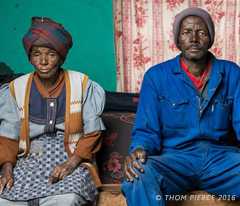
Underground mines are one of the highest risk environments for TB transmission, and miners experience some of the highest rates of TB disease across any population. Learn how CDC is working on the ground to reduce the spread of TB among mining communities around the world. These efforts help to reduce the global burden of TB and help create a safer world.
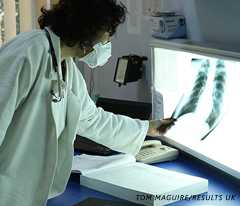
Over time, TB has become resistant to our best and most potent anti-TB drugs, threatening decades of progress that CDC and the global community has made against the disease. These drug-resistant forms require costlier, lengthier treatments with toxic drugs. Learn how CDC is on the frontlines in some of the world’s highest burden regions to understand what is driving the spread of TB and how to stop it.
Downloadable Resources
To stay in the know about global HIV and TB, please subscribe.
- Page last reviewed: March 23, 2017
- Page last updated: March 23, 2017
- Content source:


 ShareCompartir
ShareCompartir
